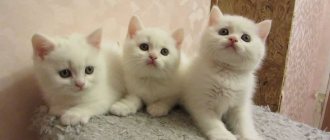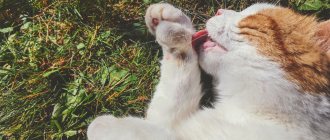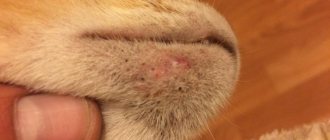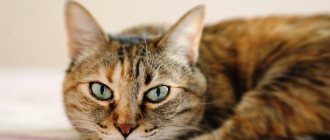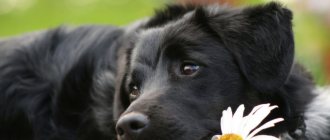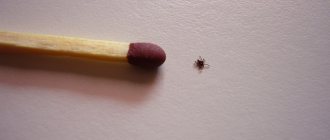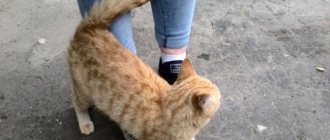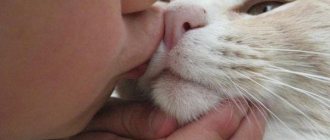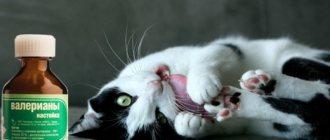Oddly enough, but a runny nose in cats is not a rare condition that occurs as a result of infection and other diseases. Accompanied by purulent or watery mucous discharge. In our article we will talk about how to identify this disease, the causes of its occurrence and consider the most common methods of treatment.
Why does a runny nose occur in cats?
A runny nose in cats can occur due to a cold. If your pet has been exposed to a draft or has been in a cool room for a long time, then most likely this is the cause of rhinitis. Additionally, the symptom occurs when exposed to any allergen: food, chemical, parasitic.
Another cause of a runny nose is considered to be viral and bacterial infections, which can penetrate the nasal mucosa of a pet with a weakened immune system. Normally, a cat’s body resists pathogens, but if some kind of failure occurs, a characteristic disease occurs.
A cat's runny nose may be due to a cold.
Less commonly, rhinitis appears under the influence of fungal flora, which affects not only the skin, but also the mucous membranes. The provoking factor for the occurrence of the symptom can be a neoplasm that forms in the nasal cavity. Additional reasons:
- diabetes;
- congenital anomalies of the nasopharynx;
- inflammatory process occurring in the middle ear;
- injury to the mucous membrane.
It is not possible to determine the triggering factor for a runny nose at home, so you should consult a doctor immediately after the symptom appears.
Causes of rhinitis in a pet - video
Prevention
To treat your cat less frequently for colds and runny noses of other etiologies, you should follow these simple recommendations:
- Say no to drafts! There is no room for drafts in rooms where children and pets are present.
- If your cat is prone to allergic diseases, do wet cleaning more often and protect it from “encountering” allergenic substances.
- Keep your pet away from outdoor cats and dogs.
- Do not place your four-legged pet's bed in a cold place.
- Carry out vaccinations and timely treatment against parasites and worms.
- Provide your pet with adequate nutrition, and do not forget about fortifying the food.
Symptoms and diagnostic features
Symptoms that may accompany rhinitis in a pet:
- lacrimation;
- discharge of mucus from the nose;
- lethargy;
- decreased appetite;
- increase in body temperature.
If the symptom is triggered by an allergy, then itching, swelling and redness of the skin and mucous membranes may additionally be present. Bacterial rhinitis is characterized by purulent nasal discharge. In this case, the animal often develops a fever and practically does not get up. The introduction of a viral or fungal infection is also accompanied by copious mucous discharge from the nose and fever.
If, in addition to a runny nose, the cat is itching, this may indicate an allergy.
If parasites are present, the symptom does not go away for a long time and cannot be treated. Additionally, a cough may develop, appetite may worsen, and the pet will lose weight. With congenital anomalies in the development of the nasopharynx, a runny nose is present from the very birth of the kitten and accompanies it throughout its life.
What research methods help identify the cause of rhinitis:
- Allergy tests. This diagnostic method allows you to identify the provoking factor. To do this, small incisions are made on the pet’s skin, then various types of substances are applied and the reaction is monitored. This method is relevant only if the allergic nature of rhinitis is suspected.
- Examination of the nasal cavity. This type of study allows you to identify a foreign body or tumor. In this case, the doctor uses a special optical instrument.
- Blood and urine analysis. This method makes it possible to determine the inflammatory process, diabetes mellitus, and other diseases by characteristic signs. With abnormalities in the blood, the level of leukocytes, erythrocyte sedimentation rate and the amount of glucose increase. Protein and stone crystals may appear in the urine. In addition, the urine becomes cloudy and may contain bacteria and fungi.
- Skin examination. If the doctor detects any abnormalities, he may additionally perform a scraping to identify fungal microflora. A Wood's lamp is also used, with which it is easy to detect microsporia and other lesions of the epidermis.
- Stool analysis. This study allows you to identify parasite eggs and helminth fragments that can provoke the appearance of symptoms.
- Ultrasound of internal organs. This method of examination makes it possible to exclude damage to the kidneys and digestive organs and to identify possible disturbances in the functioning of the heart. If there are a large number of parasites in the pet’s body, they can be visualized in the intestines in the form of dark spots.
An important method is an examination by a veterinarian, which will identify the first signs of dangerous pathologies.
Attention! If a runny nose is a consequence of diabetes or tumors, then the animal’s condition only worsens over time, and standard treatment methods remain powerless.
Causes
It is impossible to make an accurate diagnosis and find out how to treat a runny nose in a cat without appropriate education and experience. However, if you look closely at the condition of the animal, you can determine the type of disease.
- Colds due to hypothermia, for example after swimming. Green discharge from both nostrils.
- Infection (viral, bacterial). You can catch the disease from another pet. The snot is thick and cloudy. Cats often have watery eyes.
- Infection (fungal). The disease is often chronic, and the cat has a runny nose mixed with pus and an unpleasant odor.
- Trauma, including the presence of foreign bodies in the nasopharynx. The mucus is mixed with blood, but flows out of only one nostril.
- Pathology of teeth and gums. Purulent rhinitis is observed. It can be one-sided or two-sided, this is due to where the abscesses have formed.
This is an incomplete list of reasons. The discharge may be caused by allergies, high blood pressure, or breed characteristics such as a short muzzle.
Owners do not always begin treatment for runny nose in cats immediately. If it is a common cold and there is little discharge, then you can postpone going to the veterinarian. However, if after a week the patient does not feel better, and the mucus interferes with breathing, it is worth taking action.
Therapeutic tactics
If a runny nose is caused by a common cold caused by hypothermia of the pet’s body, then you can use time-tested methods, one of which is warming up. To do this, heat sea salt in a frying pan, let it cool slightly and put it in a handkerchief. Apply the resulting bag warm to your pet’s nose and trim for several minutes. It is recommended to repeat the procedure daily for 5–7 days. Heat can be used for therapy only in the absence of bacterial flora.
Sea salt can be used to warm your pet's nose
You can also use aloe juice to eliminate rhinitis. In this case, you need to select the lowest leaf and put it in the refrigerator for half an hour, after wrapping it in parchment paper. Then rinse thoroughly and cut, carefully squeezing the juice into a glass container.
The healing liquid should be injected into the pet’s nose, one drop at a time, using a pipette. It is enough to carry out the procedure 1-2 times a day. The course of treatment should not exceed a week. If, while using aloe juice, the symptoms intensify and discharge from the eyes appears, then it is recommended to try another method.
Aloe has an anti-inflammatory effect
A good remedy to speed up recovery is beet juice. To obtain it, just rinse a small root vegetable and grate it. Then transfer the resulting mass to cheesecloth and squeeze the juice into a glass container. Use 2 times a day, 1 drop in each nasal passage for 5 days. It is not recommended to increase the dosage of juice, otherwise you may provoke unwanted reactions.
Beetroot juice speeds up recovery from a runny nose
You can use saline solution for rinsing. It is enough to inject 2-3 drops into each nostril 2-3 times a day. Treatment can be stopped after the symptoms of rhinitis completely disappear. In combination, you can use the drug Glazolin 1 time before bedtime. One drop into each nasal passage is enough to significantly ease your pet's breathing. The course of treatment with this drug should not exceed 5 days, otherwise it can cause addiction to the drug.
Glazolin relieves nasal congestion
If it is difficult for your pet to breathe due to excessive mucous secretions, then children's Naphthyzin can be used for therapy, which constricts the vessels of the nasal mucosa. In this case, it is enough to inject one drop into each nostril. It is prohibited to use this medicine for more than 4–5 days. The drug can be instilled only once a day to avoid drying out the mucous membrane.
Naphthyzin constricts blood vessels, relieving swelling of the mucous membrane
If the symptom occurs as a result of injury to the nose, then no special treatment is required. Rhinitis will go away immediately after the wound heals. However, to speed up this process, it is recommended to treat the damaged surface with Miramistin 2 times a day until complete healing. The procedure should be carried out using a cotton swab, and rinsing the nose should be done using a pipette.
Miramistin is active against bacteria, viruses and fungi
Attention! If the symptoms of rhinitis do not stop within a week, this may indicate a bacterial or viral nature of the disease.
Treatment
The concept of treating viral diseases of kittens accompanied by a runny nose is developing in the following areas:
- Antimicrobial therapy. It is almost the same for all viral diseases.
- Symptomatic treatment. To eliminate a runny nose, the same treatment strategy is used. As for other symptoms, treatment has its own specifics for each pathogen.
Antimicrobial therapy
Use the following means:
- Antiviral. On the first day of illness, Vitafel is used in the form of immunoglobulin or serum containing antibodies against Panleukopenia, Rhinotracheitis and Calcivirosis. Late passive immunization is ineffective: viruses fade into the background, and the fight against secondary microflora becomes urgent.
- Are common. Immunostimulants that stimulate the immune response are indicated. The following drugs are in demand:
- Cycloferon.
- Immunofan.
- Phosphprenyl.
- Gamavit.
- Derinat.
- Antibiotics. Necessary to prevent the development of secondary microflora that causes a runny nose, lacrimation and other symptoms.
Symptomatic treatment
To eliminate signs of rhinitis, use nasal drops:
- Anandin.
- Maxidin.
- Thymogen.
If there is no positive effect, the following medications are allowed for use under the supervision of a veterinarian:
- Naphthyzin.
- Dioxidine.
- Nazivin.
- Galazolin.
Nasal drops
How to treat viral and bacterial runny nose
If rhinitis occurs against the background of a viral infection, then drugs that can suppress the activity of pathogens and stimulate the body’s defenses are used for treatment. Such medications include Interferon, Grippferon and other similar drugs. These medications are used for administration into the nasal cavity, one drop at a time. Immunostimulants can be used for no more than a week and after consultation with a doctor. Rarely, during therapy with antiviral drugs, digestive disorders and pain in the liver area may occur, so it is dangerous to determine the dosage without consulting a doctor.
Grippferon stimulates the immune system
To speed up recovery from viral infections, Forvet, Feliferon and other drugs that increase the body's defenses are used. These medications are prescribed for a course of 7 to 10 days. These drugs are administered by injection in a hospital setting once a day. Injections can also be given at home, provided you have the skills. If after the injection the animal begins to limp, then the manipulation was performed incorrectly.
Forvet has an antiviral effect
In case of bacterial etiology of the disease, tetracycline antibiotics are used for treatment: Doxycycline, Tetracycline, etc. Fluoroquinolones can also be prescribed: Levofloxacin, Ciprofloxacin, etc. These drugs are intended for oral administration. Antibiotics are used only in dosages prescribed by the doctor, which depend on body weight and the characteristics of the infection. The course of treatment does not exceed 5–7 days. Antimicrobial drugs can provoke digestive disorders, diarrhea and vomiting, so they can be used only after confirmation of the diagnosis.
Doxycycline kills a wide range of microorganisms
Additionally, Streptocide is often used to speed up recovery. To do this, you need to first dilute 1 sachet (4 g) in 100 ml of water and let the liquid stand for about two hours. Then you can use it for instillation 3 times a day. The course of treatment should not exceed 5 days. One drop should be administered into each nostril, no more. Streptocide can only be used for a short course, because long-term treatment can lead to unwanted reactions from the pet’s body. In this case, visual impairment often occurs.
Streptocide relieves the inflammatory process
Attention! Without a preliminary examination by a specialist, it is not recommended to treat bacterial and viral types of runny nose on your own. If the tactics are incorrect, complications can arise.
Causes of snot in domestic kittens
Snot in a kitten, reasons
the appearance of which is not determined is an alarming symptom. To eliminate them, you will need antibiotics, anti-inflammatory and antiviral medications. To begin with, use “Cycloferon”, it activates the immune system, and “Anandin”. It is used when a kitten has snot of a transparent color. Giving your pet human medications is strictly prohibited.
The appearance of green snot on the kitten
indicates the transition of the disease to a severe stage.
They can be described as mucus, which interferes with breathing and, over time, forms dry crusts. If a kitten has an unusual discharge of snot
, it is much more difficult to understand how to treat
it
. Your pet will not be able to recover on its own.
When a kitten sneezes and snot
, the color of which signals increased danger, does not stop, the help of a veterinarian is urgently required.
In extreme cases, a specialist can be called to your home.
Treatment of rhinitis caused by fungi, parasites and allergens
The fungal flora that most often provokes rhinitis is called cryptococcal. To eliminate it, Itraconazole, Fluconazole and other similar drugs are prescribed. The amount of medication depends on the weight of the cat, and the course of treatment is long and lasts at least a month. The first drug is prescribed at a dose of 5 mg per kg once a day. The second medicine must be given to the pet twice a day, 50 mg. The required amount must be dissolved in 1 tsp. boiled water and pour into the animal’s mouth on an empty stomach.
During therapy with antifungal drugs, a cat's appetite may worsen, digestive problems may occur, as well as nausea and vomiting. If such symptoms appear, you should notify your doctor to adjust the dosage.
Fluconazole is active against fungal flora
To eliminate a runny nose caused by parasites, special drops are used on the withers, which can get rid of helminths, as well as fleas, ticks and lice-eaters. Such products should be used once. After 24 hours, all parasites will leave the pet’s body. Drops are applied to the skin, spreading the fur in the withers area. Most often, Dironet, Prazicide, Bars and others are used for treatment. Drops applied to the skin are generally well tolerated. Only occasionally may the pet feel worse and become lethargic.
Dironet gets rid of parasites
If a symptom occurs against the background of an allergy, then it is important to identify the provoking factor and eliminate it. Antihistamines are also used additionally for treatment: Suprastin, Zodak, Tavegil, etc. It should be remembered that these medications do not eliminate allergies, but only relieve symptoms. It is enough to give the animal a quarter of a tablet per day on an empty stomach. The course of treatment should not exceed 7 days. When treated with antihistamines, the pet may appear lethargic, which is caused by a slight sedative effect. After discontinuation of the drugs, the animal’s condition returns to normal.
Tavegil relieves allergy symptoms
It is recommended to provide your pet with rest during treatment. It is important to protect your cat from stress, monitor its diet and prevent hypothermia.
How to rid a cat of a runny nose - video
Symptoms
To understand that your cat has some kind of problem, you need to pay attention to the following symptoms:
- Symptoms of viruses: runny nose, snot, suppuration of the eyes, vomiting, loss of appetite, diarrhea, while the general condition of the animal usually suffers. In this case, a doctor's consultation is necessary. Sometimes the presence of the virus in a pet can be fatal, and the time passes by for days.
- When a pet is allergic, symptoms such as nasal congestion, running snot, swollen and purulent eyes, impaired respiratory function, and itching appear.
- Symptoms of polyps and tumors: the animal rubs its nose with its paws, as if something is bothering it. As a result of a tumor, asymmetry and curvature may appear on the muzzle.
- Signs of the presence of a foreign body: the cat shakes its face, sneezes, and produces snot.
How to distinguish an allergic runny nose from a cold
The doctor makes a diagnosis based on medical history, complaints, results of a clinical blood test and examination of the mucous membrane (instrumental or endoscopic rhinoscopy). In allergic rhinitis, the epithelium of the nasal passages is pale, loose, the mucous membrane of the oropharynx is not inflamed, and the level of eosinophils in the blood is increased. To confirm a suspected allergy, an enzyme-linked immunosorbent blood test for immunoglobulins E is prescribed, as well as skin prick allergy tests3.
To distinguish an allergic runny nose from a cold on your own, analyze the symptoms:
- With allergies, rhinorrhea and sneezing increase sharply when inhaling air filled with allergens. They irritate the ciliated epithelium of the nasal mucosa. For example, hay fever manifests itself more intensely outdoors in hot, dry weather. With viral rhinitis, external factors do not affect the amount of secretion from the nasal cavity.
- Allergic rhinitis develops acutely and is not accompanied by hyperthermia. Cold symptoms increase gradually, body temperature can reach 38-39℃.
- Discharge from the nasal passages with a cold changes in color and texture, while with allergies it remains watery.
- Itchy skin, watery eyes and red eyes are characteristic signs of allergies, and they are rare with colds.
- Symptoms of a viral infection disappear under the influence of antiviral drugs and vitamins. For allergies, this treatment does not produce results.
- Sensitivity to irritants is dulled after taking antihistamines. Antiallergic medications do not work on colds.
Also, allergic status is often inherited. You can suspect an allergy if there are asthmatics and allergy sufferers in the family.


